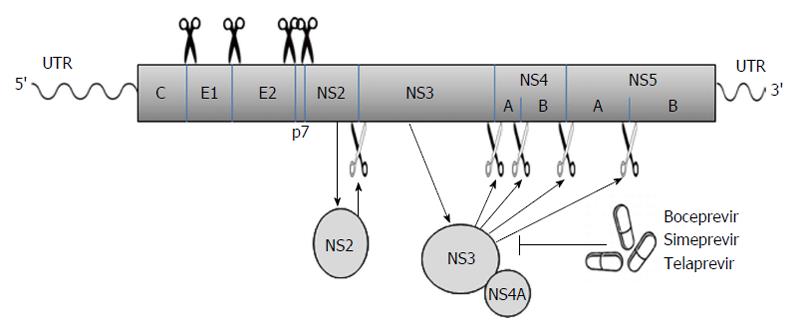Copyright
©The Author(s) 2015.
World J Hepatol. Jun 8, 2015; 7(10): 1377-1389
Published online Jun 8, 2015. doi: 10.4254/wjh.v7.i10.1377
Published online Jun 8, 2015. doi: 10.4254/wjh.v7.i10.1377
Figure 1 The hepatitis C virus poly-protein is processed co- and posttranslationally by host and viral proteases into at least 10 different proteins, which are arranged in the order of NH2-C-E1-E2-p7-NS2-NS3-NS4A-NS4B-NS5A-NS5B-COOH.
Host signal peptidase is required for the cleavages at C-E1, E1-E2, E2-p7, and p7-NS2 junctions. NS2 cleaves the site between NS2 and NS3; NS3/4A serine protease cleaves the sites at NS3-NS4A, NS4A-NS4B, NS4B-NS5A, and NS5A-NS5B junctions. Several new DAAs (e.g., boceprevir, simeprevir, and telaprevir) specifically designed to inhibit the NS3/4A protease are now becoming available. The wavy lines mark the un-translated regions (UTR) of hepatitis C virus genomic RNA while the rectangle represents the poly-protein derived from the long open reading frame.
- Citation: Li HC, Lo SY. Hepatitis C virus: Virology, diagnosis and treatment. World J Hepatol 2015; 7(10): 1377-1389
- URL: https://www.wjgnet.com/1948-5182/full/v7/i10/1377.htm
- DOI: https://dx.doi.org/10.4254/wjh.v7.i10.1377









